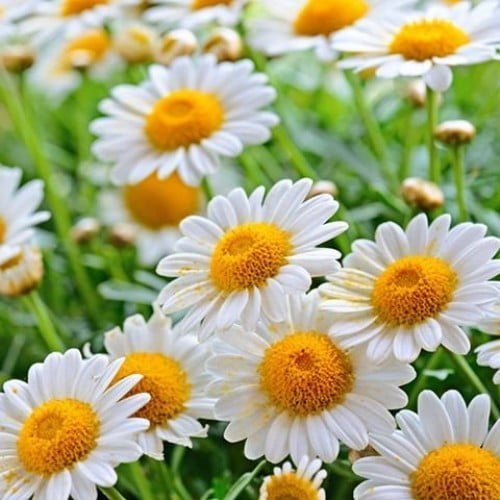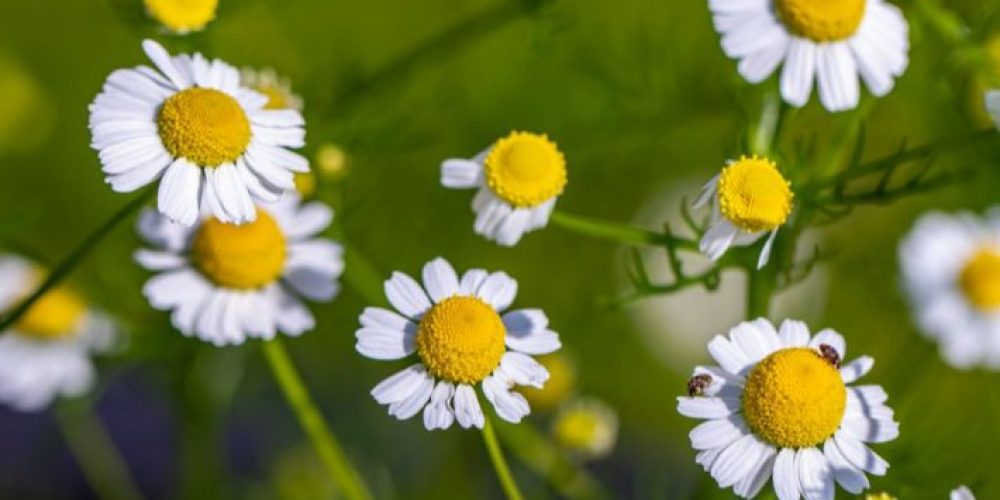Table of contents of the article
ToggleGrowing chamomile is a fun and easy experience that allows you to benefit from its health and beauty benefits directly from your garden. In this article on your website, WORLD OF PLANTS, we will learn about the steps for planting and caring for chamomile to ensure a successful harvest.
What is chamomile?
Chamomile is a flowering plant that belongs to the Asteraceae family and can be grown in several ways. What distinguishes this plant is the yellow or white radial chamomile flowers. These flowers, along with the chamomile leaves, have many benefits and uses, including the manufacture of medicines, cosmetics, and decorations. Chamomile is also used to treat a group of A variety of health problems, if the chamomile plant is planted in the correct way and taken care of in the necessary manner. It is also grown for its beauty and scent. In this article, we will learn about ways to grow a chamomile plant and how to take care of it to get the best results.
Methods of growing chamomile
Here are the most prominent ways to grow chamomile:
Growing chamomile from seeds
First, get the chamomile seeds and start planting them indoors about six weeks before the last expected frost. Then scatter the seeds on the soil and press them without covering them with soil, because the seeds need light. Then water them regularly. The seeds will germinate within 7 to 14 days.
Growing chamomile from seedlings
Chamomile is also grown from seedlings by following the following steps:
- After preparing the soil and mixing it with nutrients, make a hole large enough to accommodate the plant's root ball.
- Remove the chamomile plant from its original pot and gently loosen the roots.
- Place the plant in the hole, ensuring that the top of the root ball is at the same level as the surrounding soil.
- Fill the remainder of the hole with more soil, pressing firmly but gently around the base of the plant.
- Water the plant well to remove air pockets in the soil.
- A layer of mulch can be spread around the base of the plant to help prevent weeds and retain soil moisture.
- Space the seedlings by 20-30 cm to ensure good air circulation.
Suitable conditions for growing chamomile
Below we will mention the conditions that chamomile needs to grow optimally:
- The appropriate time for planting: Chamomile seeds are planted outside in late spring or early summer. This is to avoid the risk of frost.
- Environmental conditions: Chamomile needs exposure to full sunlight, but it prefers to remain in partial shade in hot climates. Chamomile also thrives in moderate temperatures ranging from 15.5 to 20 degrees Celsius, and can flourish in very humid areas.
- Soil type: Chamomile is one of the plants suitable for planting in sandy, well-drained, organic and nutrient-rich soil. It is preferable for the soil acidity to be within a neutral range ranging from 5.6 to 7.5 pH.

Ways to care for chamomile
Chamomile plants can be taken care of by following the following methods:
- Watering: The soil surrounding chamomile plants must remain constantly moist. Chamomile needs about one inch of water per week throughout the growing season. Once it reaches maturity, the soil can be allowed to dry before watering it again.
- Fertilization: Chamomile does not need a lot of fertilizer, as it is enough to fertilize it at the age of 3 months with half the amount recommended on the fertilizer container.
- Pruning: At the end of the season, the stems are cut as much as possible, so that the plant will flourish the following spring. The wilted flowers can also be cut as soon as they fade to stimulate the plant to produce new flower heads. The plant can be pruned into a ball shape before winter so that it grows in a circular shape in the spring.
- Harvesting: Correct harvesting of chamomile helps it reap its full benefits. It is ready for harvest when the flower petals begin to droop back, and this occurs 3-4 months after planting. Harvesting is done by cutting the flower heads from each stem with scissors. The flowers can then be dried and stored.
Chamomile varieties recommended for planting
There are two varieties of chamomile plant recommended for cultivation:
- German chamomile: Its leaves are feathery, fragrant, and daisy-like, and its height reaches 45 cm. The flowers and flower heads of German chamomile are a natural source of essential oil production.
- Adequate moisture conditions must be provided in the field before direct sowing, as this is necessary to avoid incomplete and poor germination.
Tips to ensure the success of growing chamomile
Here are the most important tips for growing chamomile plants:
- Do not harvest chamomile immediately after rain, as the flowers are wet. Rather, you must wait at least two days to give them enough time to dry.
- It is recommended not to fertilize too much, as too much fertilizer produces weak-flavored leaves and fewer flowers.
- If you are planting in agricultural containers, raise them slightly from the ground to get rid of excess moisture that causes rot during the winter.
- Make sure that the planting site is well prepared and free of weeds and weeds. Herbicides can be used to achieve this. In saline and alkaline soils, it is sufficient to remove weeds once after one month of planting. Once the plant grows, the weeds and weeds suffocate it.
- Adequate moisture conditions must be provided in the field before direct sowing, as this is necessary to avoid incomplete and poor germination.
How to grow chamomile flower at home
The light that a chamomile flower needs
- The chamomile flower must be exposed to sunlight, as it grows quickly if it is placed in a place that fully receives sunlight. However, if the weather is very hot, it is better for it to be covered with some shade, especially at noon, and this is considered new for chamomile as well. The chamomile flower is considered delicate to sunlight. Too much heat can burn the flower, and exposure to the sun helps the flower bloom in the spring, and the flower may not bloom if it is planted in a dark place.
Suitable soil for chamomile flower
- The most famous types of chamomile must be grown in good organic soil. The flower can live in regular soil, but it will be fragile, as the flower stems will be weak. It is best for the soil acidity when planting chamomile to be between 5.6 and 7.5, and there is no need to add fertilizer. For chamomile as it grows quickly without feeding the soil.
Water the chamomile flower with water
- The chamomile flower should be watered moderately on a weekly basis and allowed to dry from time to time during the weekly watering process. As the chamomile flower grows older, it stabilizes and becomes drought tolerant. In very hot weather, the flower should be watered more often than usual.
The appropriate temperature for chamomile flower
- The best weather for chamomile flowers is humid weather, and chamomile can be grown at all temperatures. If the temperature is below 38 degrees Celsius, the flower can live and grow, but the best weather for chamomile ranges between 16 to 20 degrees Celsius.
The best time to plant chamomile flower
- The best time to plant chamomile is in the fall, then let it grow and spread in the winter, and get the perfect chamomile flower in the spring.
How to grow chamomile flower
- Chamomile seeds grow easily and smoothly. Plant the flower seeds about 6 weeks before the end of the frosts and place them in a place exposed to the sun. After scattering the seeds on soil, they must be pressed without covering them completely with soil. Water them regularly, and they are expected to grow after 14 days.
Treating chamomile from insects
- The chamomile flower is anti-insect, as it repels insects from the home garden, but aphids can pose a problem to the flower, but the insects can be killed by insecticides.
Picking the chamomile flower
- Chamomile flowers are harvested when they bloom and give off their yellow and white color. After harvesting, they can be used fresh or stored in a cool, dark place.
In conclusion, we would like to note that we, at the world of plants website, offer you all the necessary services in the world of plants, we provide all farmers and those interested in plants with three main services::-
- Artificial intelligence consulting service to help you identify diseases that affect plants and how to deal with them.
- Blog about plants, plant diseases and care of various crops ... You are currently browsing one of her articles right now.
- An application that provides agricultural consultations to clients, as well as a service for imaging diseases and knowing their treatment for free – Click to download the Android version from Google Play Store، Click to download the IOS version from the Apple App Store.
References




